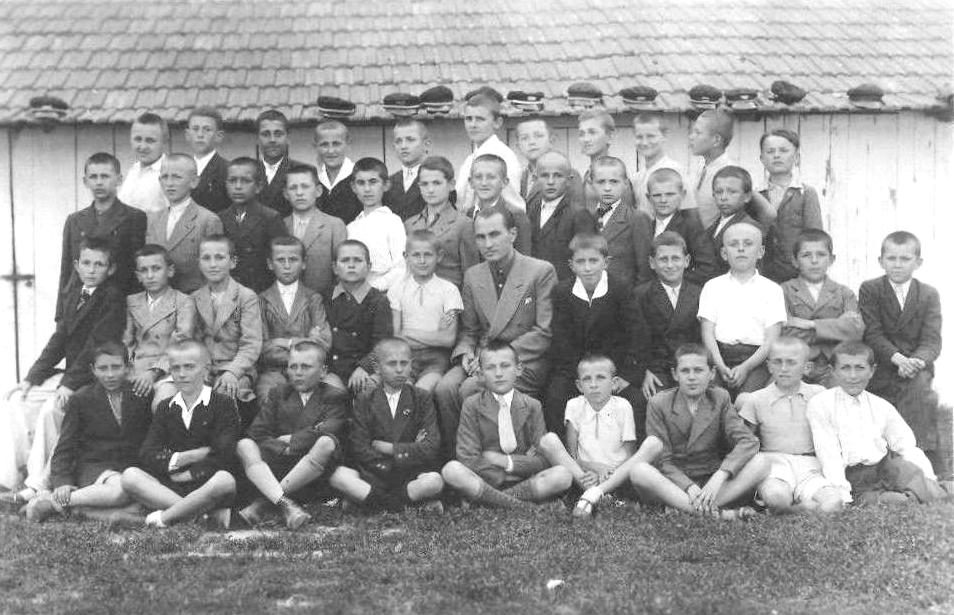
Croatian Schools: Chronology--Royal Yugoslavia (1920s-30s)

Figure 1.--Here we see an all boys Croatian primary class we think in the mid-1930s. Notice how large the class is, over 40 boys. This looks to be a small town, not a rural school. You can see the school building in the background. The boys seem very well dressed. Most wear suits. Notice a few wear long pants. Notice the German-style cadet school caps the boys have placed on the roof behind them. We are not sure if that means that they are beginning a secondary proigram.
|
|
After World War I, Crotia became part of the new Yugoslav Kingdom. Yugoslavia was the new combined country for the southern slavs built around pre-War Serbia. There was a well-established public school system in Croatia. This meant that the Hapsburg eduction system had to be coordinated with the Serbian education system. Yugoslavia was a federal state, thus there could be differences within the country. And Croats may have largely controlled the schools in Croatia. Here we do not hve much information. We are not sure how this was carried out and the results. During the Royal Yugoslav period, the Croatians had much more control over the schools. We are unsure just what the Federal role was. Croatia was the primary eistance to Serbian domination of the country. As part of the former Hapsburg-controlled Austro-Hungarian Empire Empire, Croatia education was heavily influenced by Austrian (German) norms. Croatians resented Serbian control of Yugoslavia and this destabilized the Yugoslav state poliically. Language was often a major factor in nationalist agitation. This was not the case in Croatia as the Serbs and Croats spoke the same language--Serbo-Croatian. Part of Croatia with an Italian population was awarded to Italy as part of the World War I peace settlement. We have some information on a school at Parenzo on the Istrian Peninsula near Trieste when it was part of Italy. The Italians were disatisfied with the award and wanted a much larger area of the Adriatic Yugoslav coast. School was free at the primary level in Yugoslavia, but we know little about secodary schools.
HBC-SU

Related Chronolgy Pages in the Boys' Historical Web Site
[Main Chronology Page]
[The 1880s]
[The 1930s]
[The 1940s]
[The 1950s]
[The 1960s]
[The 1970s]
[The 1980s]
Related Style Pages in the Boys' Historical Web Site
[Smocks]
[Berets]
[Long pants suits]
[Shortpants suits]
[Socks]
[Eton suits]
[Jacket and trousers]
[Blazer]
[School sandals]
Navigate the Boys' Historical Clothing School Uniform Pages
[Return ton the Main Croatian school chronology page]
[Return ton the Main Croatian school page]
[Australia]
[Austria]
[Belgium]
[England]
[France]
[Germany]
[Ireland]
[Italy]
[Japan]
[New Zealand]
[Scotland]
[Serbia]
[Yugoslavia]
[United States]
Navigate the HBC School Section:
[About Us]
[Activities]
[Chronology]
[Clothing styles]
[Countries]
[Debate]
[Economics]
[Garment]
[Gender]
[Hair]
[History]
[Home trends]
[Literary characters]
[School types]
[Significance]
[Transport and travel
[Uniform regulations]
[Year level]
[Other topics]
[Images]
[Links]
[Registration]
[Tools]
[Return to the Historic Boys' School Home]
Created: 5:48 AM 7/14/2017
Last updated: 5:48 AM 7/14/2017




